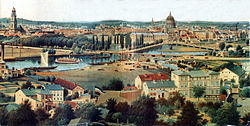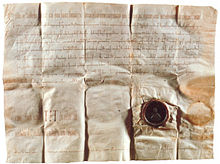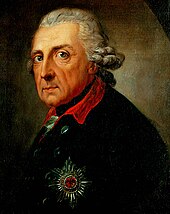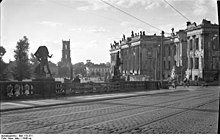History of the city of Potsdam

The history of Potsdam spans more than a thousand changeable years. The beginnings of urban development are marked by the battles with the Holy Roman Empire up to the final conquest by Albrecht the Bear in 1150. For the following centuries, the city remained a small town with no national significance. The further development of the city was largely determined by the choice of Potsdam as the Brandenburg-Prussian residence city by the Great Elector Friedrich Wilhelm from 1660 to 1918. After the end of the Second World War, the Potsdam Conference was held, which sealed the division of Germany into zones of occupation. After reunification in 1990, Potsdam became the capital of the newly founded state of Brandenburg .
Name formation and history (400–1000)
During the migration of peoples from the 4th century onwards, the Suebi , the Elbe-Germanic branch of the Semnones, left their home on the Havel and Spree in the direction of the Upper Rhine, with the exception of a few remaining groups. In the 6th and 7th centuries, Slavs moved into what was probably largely an empty area . During this period the Slavic Heveller tribe built a castle on the Havel opposite the confluence of the Nuthe . The first documentary mention of the place took place in a deed of donation from Emperor Otto III. of the Holy Roman Empire as Poztupimi (after Karlheinz Hengst old Polish for "access, landing stage") on July 3, 993 . The donation was to be made to his aunt, Abbess Mathilde von Quedlinburg . The document probably remained ineffective for the time being, as the German rule had been pushed back to the Elbe due to the Slav uprising of 983. The document mentions the two places Poztupimi et Geliti , which today are interpreted as Potsdam and Geltow . The exact origin of the name is not clear, Poztupimi is possibly derived from the Slavic words pod and stupa , which can be translated as "under the oaks". Another possibility is the derivation of a Slavic personal name Postapim .
The importance of the region was based on mastering the Havel crossing. Still, the city was isolated from major trade routes and surrounded by water and swamps. The inhabitants lived mainly from agriculture, animal husbandry and fishing.
Development in the Middle Ages (1000–1600)
The Holy Roman Empire continued its eastern colonization more decisively in the years that followed. It was not until 1150 that Albrecht the Bears finally captured the city of Potsdam . He founded the Mark Brandenburg in 1157 and thus became the first Margrave of Brandenburg. Through Albrecht, the Nordmark actually became part of the Holy Roman Empire as the Mark Brandenburg. A German stone tower castle was built at the Havel crossing, about 700 m from the Slavic castle. A small service settlement developed next to the castles. The original Slavic castle was probably still preserved. In 1304 Potsdam was first mentioned as "Stedeken" (small town).
In 1317 the first documentary mention was made as a castle and, above all, as a "city" under the name of Potsdam. In 1345 Potsdam was granted city rights and for a long time remained an insignificant small urban market town. From 1416 until the end of the First World War and the associated fall of the monarchy in Germany, Potsdam remained in the possession of the Hohenzollern family . Two major fires in the 16th century caused severe damage to the city. The urban areas were often mortgaged and so changed hands. In 1573 only 2,000 people lived in the city in a total of 192 houses. The number of historical sources from the time before the 16th century is relatively small, on the one hand records were lost in fires, on the other hand the importance of the city was low.
Prussian royal seat (1600–1800)
The great elector (1640–1688)

The absolutist era in Brandenburg began with the Electoral State Parliament in 1653, at which the Great Elector Friedrich Wilhelm restricted the power of the landed gentry. His reign was one of the most influential in the history of Brandenburg and Potsdam. He bought the individual pledged urban areas together and decided to develop the city into his second residence next to Berlin. This was followed by a boost in development, including the conversion of the older castle into a city palace and the beautification of the area. The choice to the area of Potsdam can be attributed to several reasons. The relatively untouched nature and the rich hunting grounds made it possible for the elector to pursue his predilection for hunting. In addition, there was hardly a developed bourgeoisie that could face the Willem of the court.

After the end of the devastating Thirty Years War, only 700 people remained in the city. When Potsdam officially became a residential city in 1660, 119 of 198 houses were still uninhabited. 29 households were considered impoverished and could not pay taxes. It was only with the help of the Edict of Tolerance of Potsdam in 1685 that the regions could be repopulated due to increasing immigration. Especially the persecuted Protestant Huguenots from France fled to the protection of the Brandenburg areas. Around 20,000 people took up the offer and helped the economy to flourish with their specialist knowledge. French culture was well developed in the fields of literature and architecture, among other things. The French Quarter (approx. 50 houses) was built in the city of Potsdam from 1719 as part of the first urban expansion, but it was destroyed in the Second World War. The French Church , which is now the oldest preserved church in the historic city of Potsdam, was preserved. The influential descendants of the Huguenots include the writer Theodor Fontane , the master builder Carl von Gontard and the former Federal Minister of the Interior Thomas de Maizière . Recalls a relief on the shooting of Huguenot refugees by Friedrich Wilhelm I. Geneva Reformation Monument .
Friedrich Wilhelm I (1713–1740)
Under the soldier king Friedrich Wilhelm I , Potsdam developed particularly in structural terms through two city expansions. Since the king had his soldiers' battalions completely relocated from Königs Wusterhausen to the city, new space had to be created accordingly. Until this was available it was billeted in the houses of the local population. Two to six soldiers were to be picked up and provided with clothing and food. The first and second city extensions were built north of the previous old town around the city palace from 1720. The facades were initially kept simple because the king had prescribed an economical building style. A city wall served as the outer boundary, the gates of which are still partially preserved today (including the Brandenburg Gate, Nauen Gate). This should make it more difficult for the hired soldiers, also known as Lange Kerls , to desert. What was remarkable about the new city quarters was the location of the streets, which, viewed from above, looked like a chessboard. The three newly built churches, the Holy Spirit Church, St. Nikolai Church and the Garrison Church also formed one line. Friedrich Wilhelm I. thus gave Potsdam a structured face for the first time.
Frederick the Great (1740–1786)
Frederick the Great shaped the fate of the royal seat of Potsdam, especially in artistic and architectural terms. From 1745 onwards he had entire streets redesigned and given baroque facades. These were often only faded in, but gave the city a splendid appearance, which was further enhanced by further projects such as the renovation of the city palace or the design of the old market . His most important palace, the Sanssouci Palace , was built on a mountain in the northwest, later the vineyard in Sanssouci Park. He had the park itself redesigned into his residential garden through the construction of other important buildings in the Frederician Rococo style. 50 years later it opened up to the bourgeoisie.
In terms of culture, Potsdam developed into a center in Prussia alongside Berlin . Friedrich valued the ideas of the Enlightenment and promoted science and art. The important Enlightenment philosopher Voltaire was invited to the court of Sanssouci in 1750 at the request of the king. He took up the well-paid post of Royal Chamberlain and was treated like a high-ranking guest.
Urban development (1800-1918)
On the night of October 21-22, 1806, Napoléon Bonaparte and his troops reached the city of Potsdam. The lasting effects of the occupation weighed heavily on the population and set the city back in its development for a long time. The visit of Napoleon to the grave of Frederick the Great in the crypt of the garrison church with the traditional statement: "If he had still been alive, I would not be here" was remarkable .
From 1815 Friedrich Wilhelm III. the city to an administrative center. Numerous government officials settled in Potsdam. In 1838 Prussia's first railway line went into operation with the Potsdam – Berlin line.
Main article → Architecture of Potsdam under Friedrich Wilhelm IV.
The increasing tensions during the pre- March period erupted in the March Revolution of 1848. The people fought on the barricades in neighboring Berlin for a liberal constitution. After the fatal shots by the military, Friedrich Wilhelm IV paid his respects to the 187 dead on Berlin's Schloßplatz . On March 29, the king moved to the supposedly quieter neighboring city of Potsdam. But on September 12, 1848, the spark of the revolution also spread to Potsdam. Mutinous soldiers gathered in front of the New Palace to discuss matters . When the soldiers tried to free captured comrades from arrest, the uprising was quickly put down by Prussian elite troops. The "Potsdam mutiny" remained only a brief episode of the German Revolution.
After the turmoil of the incomplete revolution, the restoration of the old balance of power was the predominant goal. In 1848 the short-lived Potsdam Association for the German Language was founded. Numerous ambitious building projects were pushed forward, such as the Nikolaikirche (1850) and the Catholic Church of St. Peter and Paul in 1867. The tall buildings still shape the cityscape today. The year 1888 went down in German history as the three emperor year . To William I , who died on March 9, followed by his ill with throat cancer son Friedrich Wilhelm as Frederick III. who died on June 15th after a 99-day reign. He was followed on the same day by his eldest son Friedrich Wilhelm as German Emperor and King of Prussia Wilhelm II.
In 1897 the first wireless telegraphy in Germany between the Heilandskirche at the Port of Sacrow and the sailor station Kongsnæs at the Glienicke Bridge over a distance of around 1.6 kilometers. In 1907, the Potsdam tram introduced electrical operation. Potsdam had a 25 hectare airship port on the Pirschheide since 1911. The ambitious plans envisaged a European aviation center under the direction of the airship inventor Graf Zeppelin . The largest airship hangar in Germany was built as early as 1912. From 1914 war airships were built, production was stopped in 1917 and the hall was demolished in 1920.
In 1914, the last Prussian king and German Emperor Wilhelm II signed the declaration of war against the Entente powers in the New Palais . After the end of the First World War , the era of the monarchy also ended with the November Revolution and Wilhelm II fled into exile in Holland in 1918. The city of Potsdam lost its status as a royal seat for good.
Weimar Republic and National Socialism (1918–1945)
The lost war exacerbated the need and misery in Germany. The extensive property of the Hohenzollern in castles and real estate was initially confiscated by the new government and after the property dispute between the Prussian state and the House of Hohenzollern in 1926, most of it became state property.
At the beginning of the Nazi era, Potsdam Day took place on March 21, 1933 . At the staged state act, the aged Reich President Paul von Hindenburg shook hands with the new Reich Chancellor Adolf Hitler . This should be understood as a symbolic gesture for an alliance between the old order and National Socialism. The constituent session of the Reichstag took place without the Social Democrats and Communists in the Potsdam Garrison Church , as the Berlin Reichstag was not available due to the fire damage. The event was broadcast nationwide.
The city center of Potsdam was destroyed in the last phase of the Second World War on April 14, 1945 by a night British air raid on Potsdam . The main destination was given as the main station, but the real destination, like in many other bombed cities in Germany, was the old town. This resulted in total write-offs, particularly in the southern old town of Potsdam, the most important buildings went up in flames ( city palace ) or burned in the course the night by flying sparks ( garrison church ). A few buildings initially suffered only slight damage, including the Nikolaikirche , the Old Town Hall and the Schauspielhaus am Kanal, as well as some smaller districts, such as the New Market and the Dutch Quarter .
Shortly after this attack, the city was declared a fortress by the National Socialists, because the approaching Red Army was not supposed to reach the supply routes to Berlin. The railway bridge at the main train station and the Glienicke bridge were blown up. Barricades were built from destroyed trams and the Nikolaikirche and Heiligengeistkirche were manned by observation posts. In the last days of the war these towers were shelled by the Soviet artillery. The tower of the Heiligengeistkirche burned down to a stump, the Nikolaikirche was so badly damaged that it could not be inaugurated again until 36 years later. For fear of attacks from observation posts, other high targets, such as the Monopteros on the military orphanage, were shot at by the artillery and badly damaged. On April 27, 1945, Potsdam was finally captured by the Red Army and the Second World War ended for the city.
Occupation and GDR (1945–1990)
In Cecilienhof Palace , the residence of the last German Crown Prince Wilhelm of Prussia , the Potsdam Conference of the victorious powers USA ( Harry S. Truman ), Great Britain (initially Winston Churchill , later Clement Richard Attlee ) and Soviet Union ( Stalin ) instead. The conference ended with the Potsdam Agreement , which sealed the German occupation in four zones.
With the establishment of the GDR , Potsdam became the administrative seat of the newly established Potsdam district from 1952 to 1990 . On July 25, 1952, the Brandenburg state parliament unanimously adopted the law "Measures to change the state structure of the GDR" and divided the state of Brandenburg into the three districts of Potsdam, Frankfurt (Oder) and Cottbus.
The socialist government had a split relationship with the legacy of Prussia. On the one hand, the cultural and artistic achievements were recognized. The first commemorative coins of the GDR were dedicated to the Prussian architect Karl Friedrich Schinkel and the statesman Wilhelm von Humboldt . Nevertheless, one saw the expression of militarism in numerous buildings and preferred the demolition instead of the reconstruction of historical buildings. So other monuments were lost, the reconstruction of entire streets in historical form, such as today's Wilhelm-Staab-Straße, remained the exception. In the early years, buildings were built in more elaborate styles to fit into the cityscape. Due to the increasing economic pressure, the cheaper prefabricated building method was later switched to, so the newer districts in the south such as Schlaatz, Waldstadt and Drewitz were built in a uniform architectural style.

The film production in Babelsberg had to be true to the line from the time of National Socialism. The Babelsberg film studio was one of the film centers in the Third Reich and the film center of the GDR as Deutsche Film AG, DEFA for short . The reconstruction of the city was documented in 1946 in the film Potsdam builds on . Propaganda films were made, but also sophisticated entertainment, as shown in the 1966 film Spur der Steine with Manfred Krug . The all too realistic portrayal of life was censored because it was "artistically very weak due to the wrong political positions of its director, just a piece of work in every respect," said the then Minister of Education, Klaus Gysi . In total, more than 700 feature films and 160 children's films were made during the GDR era. The film Jakob the Liar was the only DEFA film to be nominated for an Oscar.
In 1949 East Berlin was declared the capital of the GDR. With the building of the Wall in 1961, Potsdam lost its direct connection to neighboring West Berlin . The Berlin Wall thus also became the border between East and West in Potsdam. Noteworthy is the small western exclave of Steinstücke , which remained isolated in Babelsberg. The crossing at Glienicke Bridge was used to exchange spies during the Cold War. In the most spectacular transfer in 1962, the Soviet spy Rudolf Ivanovich Abel was exchanged for the US pilot Francis Gary Powers . Immediately after the fall of the Berlin Wall in 1989, the bridge could be used again by the population as the “bridge of unity”.
The bridge was renamed Glienicke Bridge back in 1984.
Federal Republic of Germany (1990-present)
When the state of Brandenburg was re-established after German reunification in 1990, Potsdam became its capital. Since then there have been various initiatives to reconstruct some of the destroyed buildings in the city center, such as the garrison church or the city palace. As early as 1990, large parts of Potsdam's cultural landscape were designated UNESCO World Heritage Sites .
The city's millennium was officially celebrated in 1993. The city canal, which was filled in in 1963, was partially exposed again based on its old course. In 2001, the Federal Garden Show took place in Potsdam under the motto "Garden art between yesterday and tomorrow" . In 2004 the city received the gold medal in the national competition Our city is blooming .
In the 21st century, Potsdam developed into a renowned research and education location in German-speaking countries.
See also
literature
- "Potsdam in the Picture of History", Dieter Schulte and Hartmut Knitter, Potsdam 1979
Web links
Individual evidence
- ↑ a b http://www.potsdam.de/cms/beitrag/10000074/33981/
- ↑ http://www.taz.de/pt/2006/10/27/a0199.1/text.ges,1
- ↑ http://www.zeitreisen.de/1848/kap2/thema4.htm#3
- ↑ http://www.potsdam.de/cms/beitrag/10000071/33981/
- ^ History of the Brandenburg State Parliaments - The State Parliament of Brandenburg 1945–1952. Brandenburg State Parliament, 2006, archived from the original on June 4, 2007 ; Retrieved December 26, 2014 .
- ↑ Trace of the stones at www.filmzentrale.com
- ↑ The DEFA story at www.filmportal.de
- ^ Uni Potsdam is a top university , PNN, accessed on November 13, 2017.










